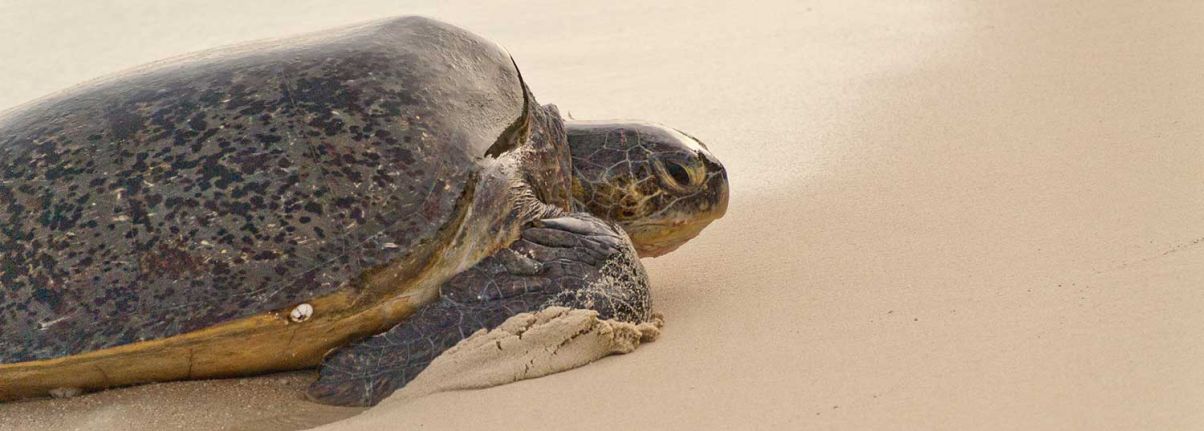
Biology and natural history
Classification in the animal kingdom
Turtles and tortoises (scientifically: Testudines) belong to the reptiles (Reptilia), a class of cold-blooded vertebrates (Vertebrata) that is basically adapted to life on land. As has often occurred with other groups in the evolutionary history of primarily land-dwelling vertebrates, which also include birds and mammals, sea turtles (Chelonioidea) have made a secondary return to life in water. However, they require air to breathe, and females must return to land to reproduce.
Within turtles, there are the two major groups of side-necked turtles (Pleurodira; retraction of the head into the shell by horizontal S-shaped movement) and hidden-necked turtles (Cryptodira; retraction of the head by vertical S-shaped movement), with most species, including sea turtles, belonging to the Cryptodira. Other known Cryptodira include land tortoises, soft-shelled tortoises, alligator tortoises, and snapping turtles. Many species are well adapted to life in water, such as the European pond turtle, which is also found in Central Europe, and the North American pond sliders. However, no group is as consistently adapted to life in water as the sea turtles.
Life cycle
- Reach sexual maturity after 10-40 years (female green sea turtles in the Western Pacific average 33 years).
- Several decades of reproductive activity (female green sea turtles in the western Pacific average 19 years)
- Excellent ability to retrieve natal site after decades of maturity
- Several years between nesting seasons (remigration intervals)
- Multiple clutches per nesting season (internesting intervals)
- Unusually high reproductive rate for reptiles (r-rate; survival probability to sexual maturity about 1:1000)
Reproduction
Mating & courting Behavior:
- Mating takes place near the nesting beaches
- Female mates only before first egg laying of each nesting season
- Male courtship behavior not very subtle
- Fierce biting fights between male
Incubation of eggs in the sand:
- Eggs are buried in sand (0.5-1m) and incubated by its temperature
- Proper conditions (temperature, sand texture, humidity) important for hatching success: turtles must be selective in choosing nesting site
Sex determination:
The determination of the sex of the turtle embryo is not done by the combination of the sex chromosomes as we do, but by the breeding temperature!
Evolution
The great age of sea turtles is often pointed out and they are often referred to as “dinosaurs of the seas”. It is a clear that the sea turtles are a conserved group of animals and have changed only comparatively slowly in the course of the earth’s history. About the exact geological age of the sea turtles, however, different data are often found.
In addition to methodological issues of principle, this is often due to differing views of what constitutes a “sea turtle”. If one excludes the leatherback turtles (Dermochelidae), one finds that the last common ancestor of the extant hard-shelled sea turtle species (Cheloniidae) probably lived about 50 million years ago. If leatherback and hard-shelled sea turtles are considered together, an evaluation of fossil evidence yields an age of the presumed last common ancestor of the two groups, and thus of sea turtles living today, of at least 120 million years ago (Early Cretaceous). This is currently (2022) the current answer to the question “How old are sea turtles?”. This is justified by the age of the fossil of the sea turtle Desmatochelys, which proves that the split of the leatherback turtle relatives from the other sea turtles happened at least 120 million years ago.
But the history of sea turtles goes back much further. The turtles themselves split off from their reptilian ancestors at least 260 million years ago (Permian). This is evidenced by the fossil find of Eunotosaurus in South Africa, an animal that still had more of a lizard-like appearance but already showed a tendency to broaden its ribs and thus form a shell. A lizard-like shape also still showed the fossil of Pappochelys coming from Germany, originating from the Middle Triassic period about 240 million years ago. The approximately 220 million years old Odontochelys (Upper Triassic), on the other hand, already looked quite similar to a turtle. The further development of the turtles leads then over the “pre-turtle” Proganochelys (approx. 210 million years, Upper Triassic). With Proganochelys the typical appearance of turtles including ossified dorsal and ventral carapace was then fully established. Proganochelys did have a horned beak like all present-day tortoises and no teeth in the jaws, but still had teeth on the palate. The teeth then disappeared completely as the turtles continued to evolve. Obviously, from the beginning of the evolution of the tortoises there were always tendencies to the formation of water-living forms.
To compare the time periods: the dinosaurs existed for about 170 million years on earth from about 235 million years ago (Upper Triassic) to about 66 million years ago (end of Cretaceous). The evolution of today’s sea turtles including leatherback turtles then also took place during the time of the dinosaurs, although the split of the species of hard-shelled sea turtles living today probably occurred afterwards in the Tertiary period about 50 to 30 million years ago. The last common ancestor of humans and their closest relatives, the chimpanzees, lived about 8-6 million years ago; our species Homo sapiens established just 300,000 to 200,000 years ago.

